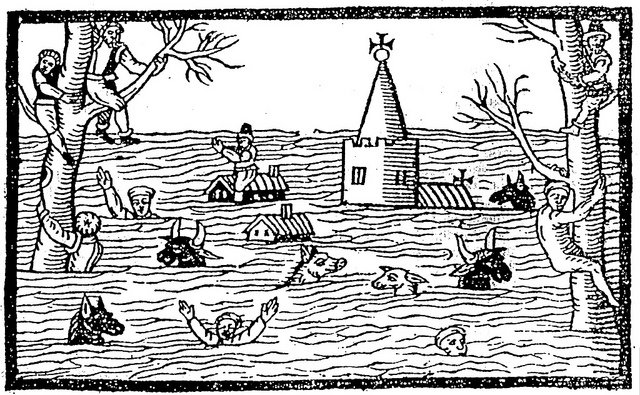
For the Dutch, the Grote Mandrake is nothing to do with Linux software, but means "The Great Drowning" and is named for the epic and massive flooding that occurred, more and more frequently in the Low Countries of Europe's North Sea region as Europe's Little Ice Age intensified.
Grote Mandrake flood killed at least 100,000
Normal or predictable spring and autumn flooding was increasingly replaced by large-area and intense flooding, sometimes outside spring and autumn from about 1300, in recurring crises which lasted into the 18th century. In the Low Countries and across Europe, but also elsewhere, the cooling trend starting in the late 13th century became more intense. It brought long cold winters, heavy storms and floods, loss of coastal farmlands, and huge summer sandstorms in coastal areas further damaging agriculture. Climate historians estimate that major flooding on an unpredictable but increasingly frequent basis started as early as 1250. Extreme events like the Grote Mandrake flood of 1362 which killed at least 100,000 people became darkly repetitive.
Comment: Global freezing: 15-year ice age predicted to hit in only 4 years as sun prepares to 'hibernate'
Other giant floods probably killed 400,000
Other giant floods in the region through the next 200 years probably killed a total of 400,000 persons in the coastlands of what is now Belgium, Germany and Holland. At the time, Europe's population was at most a quarter of today's, meaning that corrected for population size these were really catastrophic disasters. During this time, the Zuider Zee region of northern Holland was inundated and its former farmlands disappeared under water - for several centuries.
Crop failures and famines
The basic reasons was that the weather was getting colder, as well as more unpredictable. As the climate cooled, it also became wetter. Combined with the cold, this caused more crop failures and famines spread as the northern limit of farming retreated south. The start of the cooling - called Europe's Little Ice Age by glaciologist Francois Matthes in 1939 - in the 13th century was in fact the start of a long, sometimes steep dip in temperatures that held sway on an unpredictable, on-and-off basis until at least the first decade of the 19th century. Overall, the cooling lasted about 450 years.
Preceded by more than two centuries of much warmer more predictable weather
Making things worse, the cooling had been preceded by more than two centuries of much warmer and better, more predictable weather. Farming moved northwards, seasons were predictable, food supplies had expanded. Europe's population also grew, in some regions tripling in 200 years. The colonization of Greenland, which failed when the cooling intensified, was a well-known historical spin-off from the previous warming, but by the 16th century there was no trace of Europeans in Greenland. Only ruins of their farms and homes could be found, but with few or no tombstones dated beyond the early 15th century, leading to the theory that these early "Climate Refugees" packed their longboats and sailed south, to what is now the New England coast. Where they became easy prey for American Indian tribes along those coasts.
And as more evidence shows that the Medieval Warm Period was no isolated event in Europe but was a global phenomenon, McKillop's analysis takes on more immediate relevance:
This while our leaders prattle on about global warming, leaving us almost totally unprepared.
'The climate historian Hubert H. Lamb in his 2002 book Climate History and the Modern World dates the cooling to two main phases. The first leg of this change he places at about 1200-1400, but his second phase of about 1500-1825 which for some climate historians is Europe's Little Ice Age, was marked by much steeper drops in average temperatures. Indicators used by Lamb and other climate historians like Emmanuel Leroy Ladrie and Wolfgang Behringer include food price peaks as cold summers followed cold and wet springs, with increasing examples of "climate wars", such as Louis X's Flanders campaign where the climate chilling was a sure factor in play. I fear that we're headed into such a period of great cooling and repetitive catastrophic flooding right now.'
Source



repeat after me...
th w notion that the Sun and planets were by aggregation is so wanting in common sense I question the sanity of my generation
something happens and the flow of plasma ignites
and a new Sun is born
iy produces all matter from essentially nothing
if that is how you want to define plasma
we see this every day
the new matter from all over the table of elements
including gold
are throw off into space
where over time they coalesce into planets
rocky ones on the inside
gas giants further out
these huge solar holes are throwing enormous amounts of water at us
from the Sun
The "water bearer" is the process of the Sun shutting down
those clouds on high are the arrival of more water
all of which will finish its stripin time and find gorund somewhere
but it is water from the Sun
Change is coming